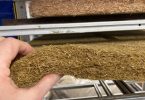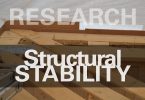This article analyses how straw and straw buildings pass the basic requirements given in Regulation (EU) No 305/2011 of the European Parliament and of the Council. The research was performed by analysing the various scientific works and test results carried out at accredited laboratories. The analysis reveals that perfectly prepared straw as well as buildings insulated with it can pass the basic requirements. During the test of required pressure of rye, triticale and oat straw it was estimated that the type of straw and humidity have not influenced the compression. During the experiment, the following aspects were also estimated: the pressure to obtain an optimal density of 90 -140kg/m³, the dependency between straw density and pressure deformations.
The research of thermal conductivity confirmed the results of other scientific works, which state that increasing the straw’s humidity increases the thermal conductivity coefficient as well. The thermal conductivity coefficient of dry straw is about 0.01 – 0.02 W/mK smaller than that of straw with 20% of humidity.
Authors: Gurskis, Vincas; Skominas, Rytis





